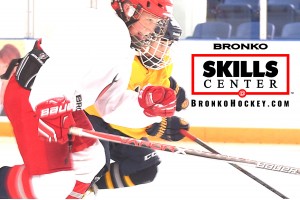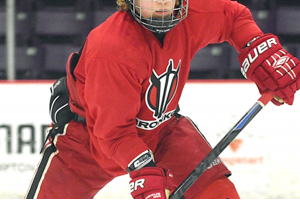 The Bronko Belt is a valuable tool for players and teams because of its versatility. It can provide a range of real benefits to players who train with it consistently while allowing coaches the flexibility to create practical and effective practice plans.
The Bronko Belt is a valuable tool for players and teams because of its versatility. It can provide a range of real benefits to players who train with it consistently while allowing coaches the flexibility to create practical and effective practice plans.
The way you use the Bronko Belt with your team will depend on a number of different factors including the age and caliber of your players, the availability of practice ice, the length of your season and the number of games you play. Below we discuss how coaches at different levels can use the Belt to train their teams.
►GETTING STARTED, SETTING GOALS
Before we discuss training options, a quick word about setting goals. Regardless of the level at which your team plays it is important to set goals, both short- and long-term. As a coach you need to identify the goals you'd like to achieve and lay out the steps required to reach them.
An important next step is to effectively communicate your goals and the plan for achieving them. Discussing individual and team goals with players, staff and parents is an important part of getting everyone pulling in the same direction.
It's important to stress the relationship between preparation and achievement. When team members understand the goals--and the steps required to achieve them--it provides focus and motivation for their daily routines.
Following the plan that you've mapped out-- following it every day-- is the final and most critical part of achieving your goals. The rest is just talk if you don't take action to make your goals happen. Of course, taking action occasionally, or when it's convenient, will not usually get the job done. Reaching your goals will require commitment and consistency.
Introducing the Bronko Belt as a tool your team will use to help you reach your goals reinforces the message that it's important to prepare well. It sends a strong signal that you expect players to use each practice to improve--even if it's just a little bit each day. Each time the Belt is worn, it's a tangible reminder to players of the goals you've discussed with them and the commitment required to achieve them.
►YOUTH TEAMS
For youth teams that, on average, play two games per week (on varying nights each week) and practice twice per week, the belt is typically used for the first 15-20 minutes of each practice. Players put the Bronko Belt on in the dressing room before going on the ice and typically perform a warm up-- possibly edge control or balance drills, puck handling and passing drills or some other sub-maximal skating drills-- before participating in higher intensity drills involving sprints and changes of direction.
For many youth teams, practice ice is limited and therefore extremely valuable. In instances where the coach doesn't have time to focus exclusively on skating, the drills performed while wearing the belt can also include puck handling and shooting and progress into game situation drills including 1v1s or 2v1s etc. Coaches don’t have to focus solely on skating when using the belt—they can concentrate on the other skills, tactics and decision making that the team needs to work on to maximize chances for success in the next game.
'Full Ice 2v1 with a Backchecker, Continuous' is a great example of the type of multifaceted drill that coaches can use while the team is wearing the Belt. It involves a high intensity sprint in a game situation and includes individuals skills (skating, passing, shooting), tactics (2v1 options for both Fs and Ds, backchecker responsibilities) and decision-making (read and react under pressure). These types of drills can be used in place of drills that focus on conditioning alone, particularly when using the Belt to boost the intensity element of the drill. Using drills that combine a number of different elements can allow a coach with limited practice ice to get the most from his ice time.
After approximately 20 minutes, when instructed by the coach, the players remove the Belts and hang them over the boards at the players bench. Removing the Belts is an easy process and happens quickly during a water break. The coach can continue with the same drill or draw up a new drill on the coach's board.
Players will immediately notice a lighter-than-air feeling in their legs and should be encouraged to skate at top speed for the following drills. They will have more jump in their stride and will feel they have more energy to continue. It's important for players to have time in practice to perform drills without the Belt so they can get reps performing skills at their maximum speed.
Players complete the remainder of practice according to the coach’s practice plan. At the end of practice each player skates to the players bench, picks up their Belt--labelled with their name or jersey number--and skates off the ice to the dressing room. Players put their Bronko Belt in the mesh carry bag provided and place the Belt in their hockey bag.
►UNIVERSITY and PREP SCHOOL TEAMS
Teams in this category often have similarly constructed schedules. Teams will typically play 30-50 games per season, with games often occurring at regular intervals each week--each Saturday and Sunday, for example. Teams often practice each day so access to practice ice is more frequent. These teams may choose to use the Belt during practice on the same days each week--Mondays and/or Tuesdays, for example--and perform conditioning or overspeed training on those days because the athletes have enough time before their next game to recover sufficiently.
The Belt gives the coach options for varying the intensity during practices. The amount of training weight players train with and the length of time they train with the Belt during a given practice can be determined by the coach. In his decision he can factor in the time of year (training camp, early season, late season etc), the upcoming schedule (number of games, strength of oppostion) and the relative strengths and weaknesses of the team at that stage of the season.
Many university and prep school teams will have their own dressing room in their home rink. Players have stalls to get dressed in where they leave their equipment and Bronko Belt. They wear the Belt when instructed to do so by the coaching staff.
More advanced uses of the Belt are possible for teams with access to more practice ice. For example, the Belt can be used for Contrast Training where players perform resisted sprints using the Belt followed by unresisted sprints. In this case, rather than removing the entire Belt, players can quickly unsnap the two weight packs and leave them on the bench. They can be quickly reattached so players can use alternating amounts of resistance during drills.
Asymmetrical Training is another advanced training option the Belt can provide. One weight pack is removed, or the weight inside it is removed, so the player carries an uneven load. This type of training can challenge the player’s balance while he skates and forces him to activate his core to stabilize the uneven load during skating maneuvers.
These more advanced uses of the Belt are more easily implemented with more mature athletes, a knowledgeable coaching staff who can implement the training and more access to practice ice.
►PRO and JUNIOR TEAMS
At the pro and junior levels in North America, teams typically play more games, ranging from 70-90 games per season. The games can be on weekends or during the week. Each week has a different practice schedule depending on when the games are scheduled. Teams go on road trips and may be away from their practice facility for extended periods.
As the season progresses, the wear and tear on players can take its toll and adequate recovery becomes as important as additional practice. Using the Belt to add resistance and intensity to practices may not be required later in the season. Teams at this level will adjust the way they use the Belt according to the time of year it is.
In the off-season the Belt can be used to help with power and speed development. In pre-season and the early part of the season it's often used for conditioning and strength endurance. Later in the season it can be used with little or no weight as part of a core maintenance program and/or prehab to help prevent injuries. The girdle effect of wearing the Belt means players will notice their core gets a workout even when they wear the Belt withouth any training weight.
It may also be the case during the season that individual players train with the belt while the team as a whole does not. For instance, players coming back from injury may wear the belt as a way to train their core and regain their conditioning before they start playing games again. Players who are on the roster but not actively playing in games may use the Belt to increase the training load they face each practice to make sure they are game ready when they are inserted into the lineup. Players may use the Belt with guidance from the coaching staff to work on specific aspects of their game for a specified duration ie. a four week conditioning program.
The Bronko Belt is a valuable addition to the arsenal of tools pro and junior teams have at their disposal. In the hands of knowledgeable coaches and trainers with access to ice time and other resources, the Belt opens up training opportunities otherwise unavailable.
"The game of hockey is constantly evolving and players and coaches have to find new ways to train and workout on a daily basis to stay on top of their game. I believe the Bronko Belt is a valuable tool for players and teams at both the pro level and the youth level."
Tim Turk
NHL Skills Coach
Carolina Hurricanes and Tampa Bay Lightning
"We have our entire organization using the Bronko Belt this year. I think paired with a good skills and development program it’ll really help the kids with their acceleration and agility. We’re going to continue having our whole organization using the Belt as we think it’s a tremendous way, at a reasonable cost, to help further [our players’] development."
Jason Allison
Former NHL Player (LA Kings, Boston Bruins, Toronto Maple Leafs)
President, Ice Warriors Hockey Association
Mississauga, Ontario
"I think it's an excellent tool for developing skating power and speed... I highly recommend using the Belt. I think every pro team, every junior team should have a couple of belts"
Brad Brown
Former NHL Defenceman (Chicago Blackhawks, Minnesota Wild)
Former OHL Assistant Coach (Barrie Colts)








